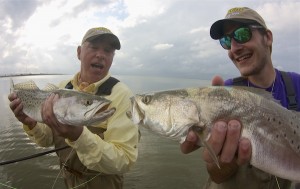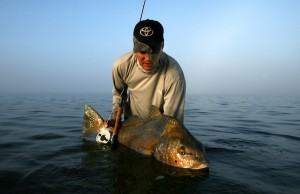 A SPECIAL REPORT by Captain John Kumiski ©2013
A SPECIAL REPORT by Captain John Kumiski ©2013
Saltwater Fishing Near Orlando
Notice to readers- Since this was written the water quality in the lagoons has decreased markedly. Much of the information contained here is no longer valid because the water is now dirty and the grass, and lots of the fish, are gone.
You get a special thrill when you go exploring and discover something good in a place where you’ve never been. Florida’s Space Coast offers a lot of saltwater fishing near Orlando.
You might think that after fishing in the same area for over 20 years that this feeling might be hard to come by. But there is so much water here, and so many different ways to approach it, that several times every year I still feel the thrill of discovery sending chills up my spine.
Where Are We?
The Space Coast lies an hour’s drive east of Disney World. The waters here include the Atlantic Ocean and the Indian River Lagoon system, with three major parts- the Indian River Lagoon, the Mosquito Lagoon, and the Banana River Lagoon. Let’s take a closer look at the lagoons.
The Indian River Lagoon (IRL)
The IRL stretches for 156 miles behind a series of barrier islands along Florida’s mid-Atlantic coast. Averaging only three feet deep, the IRL is the most biologically diverse estuary in North America. For an angler, that means there are lots of different species to target, fishing that’s available 365 days a year.
Around the Space Center those species include redfish and seatrout all year round, and black drum in the winter months. Ladyfish, sheepshead, snapper, pompano, bluefish, and several other species will sometimes find their way onto the angler’s line. During the summer months tarpon and snook can be added to the list of possibilities.
The stretch of the Lagoon that we’re interested in here lies between Titusville and the Kennedy Space Center, extending off to the north for about 10 miles and to the south as far as you would care to go.
The Mosquito Lagoon
The Mosquito Lagoon lies on the north side of the Space Center. Like the IRL it has extensive areas of shallow grass flats. At the north end a maze of islands, channels, flats, and ponds offers a superb area for those in hand powered boats to explore, fishable even on windy days.
Like the IRL, seatrout and redfish are the principal year-round targets. Black drum and sometimes bluefish appear in the winter.
The Banana River Lagoon
The Banana River Lagoon is a long arm of the IRL that extends up into the south side of the Space Center. The northernmost section of this water body is a no motor zone. No boats with motors are allowed in there. This makes it an excellent playground for those in canoes and kayaks.
It offers superb fishing for trophy redfish and black drum (as well as snook, tarpon, seatrout, and jacks in season) for those willing to invest sweat equity. The black drum up here can exceed 50 pounds and are the largest tailing fish to which you will ever cast. If you decide to visit here expect to do lots of paddling.
Unique Geography
Along the Space Coast there are only two inlets letting water into the lagoons. To the north is Ponce de Leon Inlet and to the south is Sebastian Inlet. If you are within five miles of these inlets you’ll observe tidal flow. Once you’re farther away than that there is no flow at all. The water level stays the same all day.
These lagoons have breeding populations of redfish that spawn in the lagoons. These fish grow to over 40 pounds. When conditions are good they come onto the flats, frequently in large schools. You can sometimes sight fish these fish while wading.
Tackle and Lures
While a variety of tackle can be useful here, consider a 10-12 pound spinning outfit standard. Think of sight fishing as your primary technique. A small selection of weedless single hook lures including jerk baits, weedless spoons, weedless jigs, and DOA Shrimp are really all you need, although a popping plug such as a Chug Bug does prove useful sometimes. Redfish and seatrout, our principal targets, feed mostly on shrimp, crabs, and other fish. These lures suggest one or more of these prey items.
Techniques
When faced with dirty water (fortunately fairly rare here), or cloudy skies, cast blindly. Blind casting can be effective if you’re lucky enough to pick the right spot. In order to sight fish effectively you must first find some fish and then make an effective presentation. Finding fish can be unbelievably easy, or impossible. This is fishing, after all.
Conduct the search from a skiff, from a canoe, a kayak, or on foot. All these methods work, and on any given day any one of them can be more effective than the others. With a skiff you can easily cover a lot of water. But when the fish are really skittish they won’t let you get near them.
Wading is slow, and with the muddy bottom in a lot of places it’s laborious. But you simply can’t beat wading for a stealthy approach.
If you intend to wade during the winter months waders are a must. You’ll need flats booties rather than felt soled wading shoes.
Two hazards present themselves to the wader. Stingrays frequent the flats on all but the coldest days. If you don’t see rays you won’t see much else, either. Waders must drag their feet to avoid stepping on one.
During the warmer months alligators will be seen in all these waters. I’ve never been bothered by one, but I think any large carnivorous reptile deserves my utmost respect. When I’m in the water and see a big one paying a little too much attention to me, I get out of the water and go somewhere else.
What to Look For
Fish transmit their whereabouts to the savvy angler in wide variety of ways. Most are subtle, but sometimes Ray Charles could see them.
-White Spots- these are sandy areas on a bottom otherwise carpeted with seagrass. During the cooler months trout and reds lie on these white spots and sun themselves. As a rule you’ll find more fish in an area with a bottom of mixed grass and sand than you will in an area with all grass or all sand.
-Tailers- redfish, black drum, sheepshead, and even catfish all tail.
-Mullet Schools- some times of the year, especially during the fall, the numbers of mullet simply boggle the mind. Predators of all kinds shadow mullet schools.
-Waking Fish- These fish are pushing a wave as they swim through shallow water. They could be singles, or in schools with hundreds of individuals. Redfish and jacks are most frequently seen doing this, but other kinds of fish push wakes too.
-Backing Fish- These are waking redfish, but the water is so shallow that their backs are exposed. This is ordinarily a winter behavior.
-Finned Out Fish- Schooled up redfish will fin out when the water surface is slick. They aren’t tailing, they are lying at the surface sunning themselves.
-Wading Birds- when you see several herons or egrets in the same area, stop and investigate. Bait is attracting the birds, and fish will often be in the same area.
-Diving Birds- When in the lagoons ignore the pelicans and cormorants. Gulls are marginal indicators, appearing most frequently over ladyfish. Terns on the other hand, almost always dive over real fish- jacks, trout, mackerel, or bluefish.
-Showering Bait- Mullet jump very casually most of the time. When they’re being pursued their demeanor changes. Hundreds of them will leap out of the water in unison, obviously trying desperately to vacate the area. This one is a no-brainer.
Presentations
Space Coast fish see a lot of fishermen, and they frequently demand perfection from the angler. Even when there are lots of fish around, most days fishing here remains challenging. Our discussion centers on redfish. Everything discussed here remains applicable to the other species.
While sight fishing, try to anticipate where the fish is going and put your lure there. This means you have to lead the fish by two or three feet. Then allow the fish to encounter your lure. What the fish perceives is that it’s encountered a prey item that’s trying to escape. It will usually take.
If you fish here very long you will encounter a school of fish. While the initial urge is to throw into the middle of them, this is a mistake. Whether you face a single or a school, throw it to where they’re going and wait for them to get there.
When to Go
My anglers always ask, “When is fishing best?” The easy answer, and really the only answer, to this question is “When they’re eating good!”
Many times I’ve seen the fishing be complete crap one day and on fire the next, or vice versa. On any given day, at any time of year, you can have a career day or get completely skunked.
For example, I fished a fellow by the name of Anthony Martino one day. We searched all over the Mosquito Lagoon with very little to show for it. Late in the day he caught two small trout over mudding rays, and that was it. I wasn’t very optimistic about the prospects for the next day.
I met John Campbell at the ramp the following morning, expecting another tough day. There were fish everywhere and John got 11 redfish in a half day. Thinking of Anthony’s experience, I kept telling him, “You shouldn’t have been here yesterday!”
On the Space Coast, as in most other places where I’ve fished, the best time to go fishing is whenever you can, and the best time to catch fish is when they’re biting. The only sure thing in fishing is that if don’t go you won’t catch any!
All the preceding concerns the lagoon system. We haven’t even mentioned the many fishing opportunities in the Atlantic here. There is so much Saltwater Fishing Near Orlando, enough thrill of discovery, to keep one coming back for a lifetime.
*******************************
Copyright © John A. Kumiski 2022. It is illegal to reproduce or distribute this work in any manner or medium without written permission from the author, John A. Kumiski, 284 Clearview Road, Chuluota, FL 32766 (407) 977-5207.
If you found this article useful and would like to donate to Spotted Tail, please click here…
![]()

